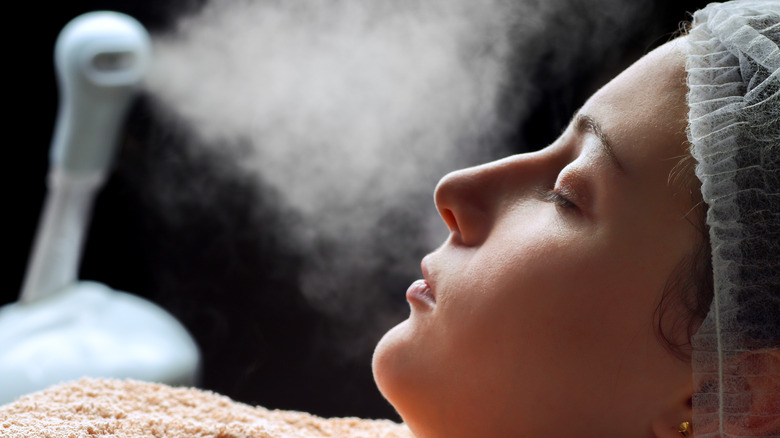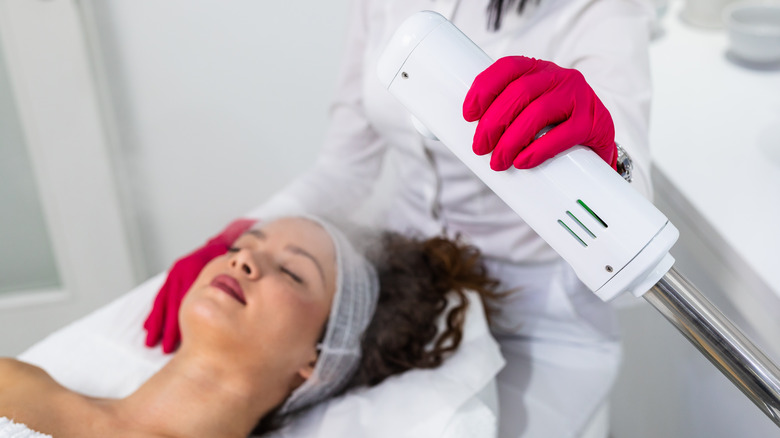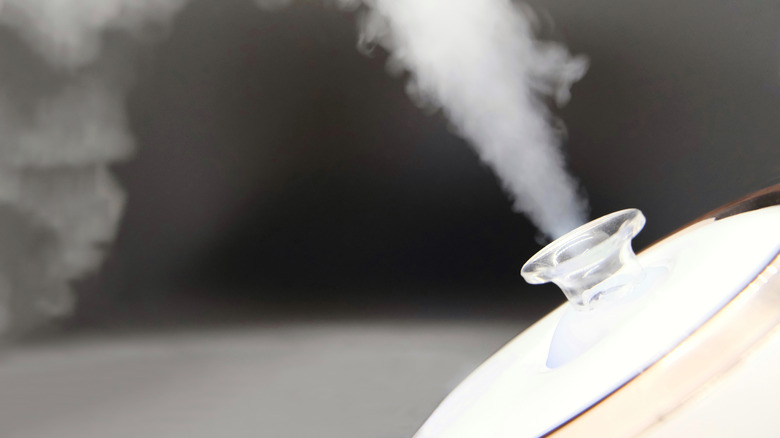What's The Difference Between A Facial Steamer And A Facial Humidifier?
Since the COVID-19 pandemic began in early 2020, the wellness world has been abuzz with at-home hacks. The Healthy reports that the use of at-home facial steamers and facial humidifiers has increased in recent years, with celebrities like Kourtney Kardashian and Gwyneth Paltrow promoting the practices. Both facial steamers and facial humidifiers can potentially lead to fresher, cleaner skin.
Facial steamers and facial humidifiers stick to the basics, using only water and a power source for creating mist, steam, and humidity to moisturize and cleanse your skin (via Cleveland Clinic). With the proper tools, precautions, and knowledge of your skin type and needs, these water-based treatments can produce many results from blackhead removal to antibacterial sanitization. Whether you're looking to shake up your skincare routine or you simply want to hydrate your skin, here is what you should know when you're choosing between a facial steamer and a facial humidifier.
Facial steamers have many advantages
There are many benefits that a facial steamer can provide. According to Healthline, steam can increase circulation, open your pores, ease sinus congestion, and help your skin absorb other products and serums. Facial steaming is a prominent method for releasing dead skin cells and bacteria deep within blackheads. When steam opens your pores, the result is the release of bacteria, oil, dirt, and other acne-causing agents. This can lead to clearer skin that is hydrated and clean. Who doesn't want that?
Traditionally, facial steaming has been a treatment available in spas and salons (per Byrdie). However, you no longer have to pay for a professional facial to experience a relaxing facial steam and its many benefits. There are several at-home facial steaming devices on the market, including wireless devices, handheld options, and appliances that serve multi-purposes. Some at-home facial steaming devices combine ionic technology, which means that they add ionization to the steaming process to get rid of pathogens on the skin's surface. When searching for an at-home facial steamer, verify whether or not it is ionic if you want the extra layer of cleanliness that ionization can provide. At-home facial steamers with ion generators are considered to be the closest option to getting the benefits of a professional facial in the comfort of your own home.
Facial humidifiers work slightly differently
The terms facial steamer and facial humidifier are commonly used interchangeably, but there is a difference between the two treatments, says The Healthy. While both practices are similar, the distinction is primarily in how much mist and moisture is produced. Facial steamers stick to their namesake by producing steam, which is by nature warm in temperature. You can think of facial steamers as creating the same type of steam you'd get from boiling water or a hot shower. In contrast, facial humidifiers produce a mist that isn't necessarily tied to a specific temperature.
Facial humidifiers are typically larger in size than facial steamers, and because they can hold more water, they usually last longer than facial steamers before needing to be refilled (per The Healthy). The purpose of a facial humidifier is to fill the air with increased moisture, rather than targeting just the face. This means the benefits of hydration, opened pores, and release of bacteria can be extended to your entire body. While facial steamer devices often have a cup-shaped design to specifically target the face, facial humidifiers are designed to release mist into the surrounding air. Facial humidifiers are usually powered by a heat source or ultrasonic technology to turn the water in their tanks into a relaxing mist. Both facial humidifiers and facial steamers can improve your wellness routine, and you may find that one or both devices help nourish your skin. If you have concerns, always consult your healthcare provider.



